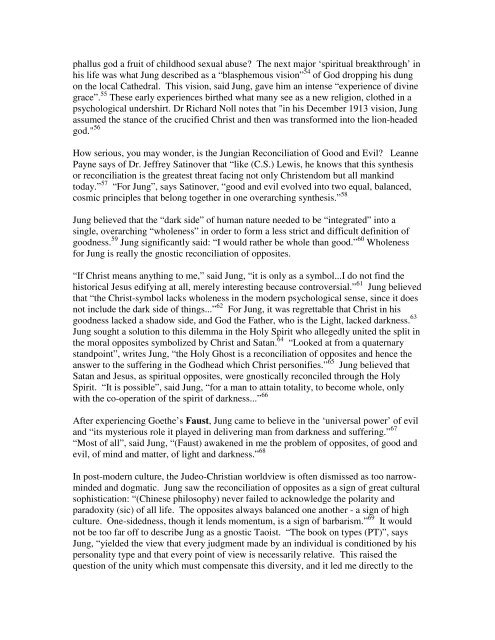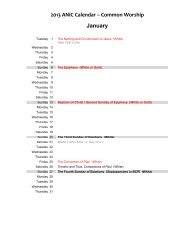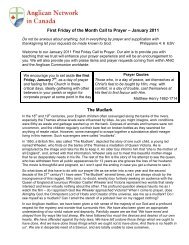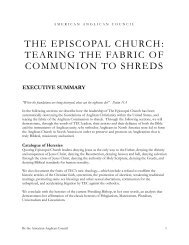Carl Jung and the Gnostic Reconciliation of Gender Opposites
Carl Jung and the Gnostic Reconciliation of Gender Opposites
Carl Jung and the Gnostic Reconciliation of Gender Opposites
You also want an ePaper? Increase the reach of your titles
YUMPU automatically turns print PDFs into web optimized ePapers that Google loves.
phallus god a fruit <strong>of</strong> childhood sexual abuse? The next major ‘spiritual breakthrough’ in<br />
his life was what <strong>Jung</strong> described as a “blasphemous vision” 54 <strong>of</strong> God dropping his dung<br />
on <strong>the</strong> local Ca<strong>the</strong>dral. This vision, said <strong>Jung</strong>, gave him an intense “experience <strong>of</strong> divine<br />
grace”. 55 These early experiences bir<strong>the</strong>d what many see as a new religion, clo<strong>the</strong>d in a<br />
psychological undershirt. Dr Richard Noll notes that "in his December 1913 vision, <strong>Jung</strong><br />
assumed <strong>the</strong> stance <strong>of</strong> <strong>the</strong> crucified Christ <strong>and</strong> <strong>the</strong>n was transformed into <strong>the</strong> lion-headed<br />
god." 56<br />
How serious, you may wonder, is <strong>the</strong> <strong>Jung</strong>ian <strong>Reconciliation</strong> <strong>of</strong> Good <strong>and</strong> Evil? Leanne<br />
Payne says <strong>of</strong> Dr. Jeffrey Satinover that “like (C.S.) Lewis, he knows that this syn<strong>the</strong>sis<br />
or reconciliation is <strong>the</strong> greatest threat facing not only Christendom but all mankind<br />
today.” 57 “For <strong>Jung</strong>”, says Satinover, “good <strong>and</strong> evil evolved into two equal, balanced,<br />
cosmic principles that belong toge<strong>the</strong>r in one overarching syn<strong>the</strong>sis.” 58<br />
<strong>Jung</strong> believed that <strong>the</strong> “dark side” <strong>of</strong> human nature needed to be “integrated” into a<br />
single, overarching “wholeness” in order to form a less strict <strong>and</strong> difficult definition <strong>of</strong><br />
goodness. 59 <strong>Jung</strong> significantly said: “I would ra<strong>the</strong>r be whole than good.” 60 Wholeness<br />
for <strong>Jung</strong> is really <strong>the</strong> gnostic reconciliation <strong>of</strong> opposites.<br />
“If Christ means anything to me,” said <strong>Jung</strong>, “it is only as a symbol...I do not find <strong>the</strong><br />
historical Jesus edifying at all, merely interesting because controversial.” 61 <strong>Jung</strong> believed<br />
that “<strong>the</strong> Christ-symbol lacks wholeness in <strong>the</strong> modern psychological sense, since it does<br />
not include <strong>the</strong> dark side <strong>of</strong> things...” 62 For <strong>Jung</strong>, it was regrettable that Christ in his<br />
goodness lacked a shadow side, <strong>and</strong> God <strong>the</strong> Fa<strong>the</strong>r, who is <strong>the</strong> Light, lacked darkness. 63<br />
<strong>Jung</strong> sought a solution to this dilemma in <strong>the</strong> Holy Spirit who allegedly united <strong>the</strong> split in<br />
<strong>the</strong> moral opposites symbolized by Christ <strong>and</strong> Satan. 64 “Looked at from a quaternary<br />
st<strong>and</strong>point”, writes <strong>Jung</strong>, “<strong>the</strong> Holy Ghost is a reconciliation <strong>of</strong> opposites <strong>and</strong> hence <strong>the</strong><br />
answer to <strong>the</strong> suffering in <strong>the</strong> Godhead which Christ personifies.” 65 <strong>Jung</strong> believed that<br />
Satan <strong>and</strong> Jesus, as spiritual opposites, were gnostically reconciled through <strong>the</strong> Holy<br />
Spirit. “It is possible”, said <strong>Jung</strong>, “for a man to attain totality, to become whole, only<br />
with <strong>the</strong> co-operation <strong>of</strong> <strong>the</strong> spirit <strong>of</strong> darkness...” 66<br />
After experiencing Goe<strong>the</strong>’s Faust, <strong>Jung</strong> came to believe in <strong>the</strong> ‘universal power’ <strong>of</strong> evil<br />
<strong>and</strong> “its mysterious role it played in delivering man from darkness <strong>and</strong> suffering.” 67<br />
“Most <strong>of</strong> all”, said <strong>Jung</strong>, “(Faust) awakened in me <strong>the</strong> problem <strong>of</strong> opposites, <strong>of</strong> good <strong>and</strong><br />
evil, <strong>of</strong> mind <strong>and</strong> matter, <strong>of</strong> light <strong>and</strong> darkness.” 68<br />
In post-modern culture, <strong>the</strong> Judeo-Christian worldview is <strong>of</strong>ten dismissed as too narrowminded<br />
<strong>and</strong> dogmatic. <strong>Jung</strong> saw <strong>the</strong> reconciliation <strong>of</strong> opposites as a sign <strong>of</strong> great cultural<br />
sophistication: “(Chinese philosophy) never failed to acknowledge <strong>the</strong> polarity <strong>and</strong><br />
paradoxity (sic) <strong>of</strong> all life. The opposites always balanced one ano<strong>the</strong>r - a sign <strong>of</strong> high<br />
culture. One-sidedness, though it lends momentum, is a sign <strong>of</strong> barbarism.” 69 It would<br />
not be too far <strong>of</strong>f to describe <strong>Jung</strong> as a gnostic Taoist. “The book on types (PT)”, says<br />
<strong>Jung</strong>, “yielded <strong>the</strong> view that every judgment made by an individual is conditioned by his<br />
personality type <strong>and</strong> that every point <strong>of</strong> view is necessarily relative. This raised <strong>the</strong><br />
question <strong>of</strong> <strong>the</strong> unity which must compensate this diversity, <strong>and</strong> it led me directly to <strong>the</strong>









